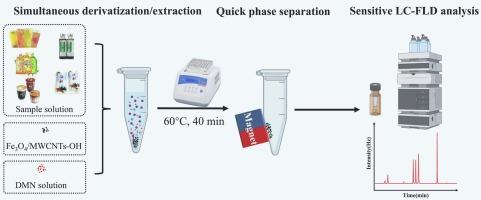Rapid and convenient determination of α-dicarbonyl compounds via streamlined simultaneous derivatization and extraction coupled with liquid chromatography-fluorescence detection
IF 6.5
1区 农林科学
Q1 CHEMISTRY, APPLIED
引用次数: 0
Abstract
α-Dicarbonyl compounds (α-DCs), formed during food heating and storage, are crucial for assessing food safety and quality. However, the low concentration, high reactivity, and absence of chromophores of α-DCs make their detection challenging, often requiring complex derivatization and extraction. This study developed a one-pot method for α-DCs that combines derivatization and magnetic solid-phase extraction. By mixing the sample, 2,3-diaminonaphthalene, and Fe3O4/MWCNTs-OH in a vial, simultaneous derivatization and extraction are achieved. Derivatization converts α-DCs into hydrophobic products, facilitating their adsorption and enabling sensitive liquid chromatography-fluorescence detection. The introduction of the magnetic adsorbent allows phase separation to be easily achieved using an external magnet, simplifying and speeding up the process. The detection limits for six α-DCs (glyoxal, methylglyoxal, diacetyl, 2,3-pentanedione, D-glucosone, and 3-deoxyglucosone) were determined to be in the range of 0.4–3.5 nM. This rapid and convenient analytical approach was successfully applied to analyze α-DCs in juices, coffees, and tea beverages.

通过简化的同步衍生化和萃取以及液相色谱-荧光检测,快速方便地测定 α-二羰基化合物
在食品加热和储存过程中形成的 α-二羰基化合物(α-DCs)对于评估食品安全和质量至关重要。然而,α-DCs 的低浓度、高反应性和无发色团使其检测具有挑战性,通常需要复杂的衍生和萃取过程。本研究开发了一种结合衍生化和磁性固相萃取的α-DCs 一锅法。将样品、2,3-二氨基萘和 Fe3O4/MWCNTs-OH 混合在一个小瓶中,可同时进行衍生和萃取。衍生化将 α-DCs 转化为疏水性产物,促进其吸附并实现灵敏的液相色谱-荧光检测。磁性吸附剂的引入使得使用外部磁铁就能轻松实现相分离,简化并加快了过程。经测定,六种 α-DCs (乙二醛、甲基乙二醛、二乙酰基、2,3-戊二酮、D-葡萄糖酮和 3-脱氧葡萄糖酮)的检测限在 0.4-3.5 nM 之间。这种快速便捷的分析方法被成功地应用于分析果汁、咖啡和茶饮料中的α-DCs。
本文章由计算机程序翻译,如有差异,请以英文原文为准。
求助全文
约1分钟内获得全文
求助全文
来源期刊

Food Chemistry: X
CHEMISTRY, APPLIED-
CiteScore
4.90
自引率
6.60%
发文量
315
审稿时长
55 days
期刊介绍:
Food Chemistry: X, one of three Open Access companion journals to Food Chemistry, follows the same aims, scope, and peer-review process. It focuses on papers advancing food and biochemistry or analytical methods, prioritizing research novelty. Manuscript evaluation considers novelty, scientific rigor, field advancement, and reader interest. Excluded are studies on food molecular sciences or disease cure/prevention. Topics include food component chemistry, bioactives, processing effects, additives, contaminants, and analytical methods. The journal welcome Analytical Papers addressing food microbiology, sensory aspects, and more, emphasizing new methods with robust validation and applicability to diverse foods or regions.
 求助内容:
求助内容: 应助结果提醒方式:
应助结果提醒方式:


